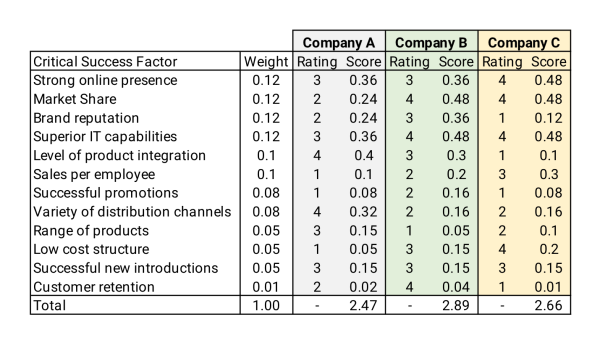The Competitive Profile Matrix (CPM) is a tool that compares the firm and its rivals and reveals their relative strengths and weaknesses[1]. In order to better understand the external environment and the competition in a particular industry, firms often use CPM[2]. The profile matrix identifies a firm’s key competitors and compares them using industry’s critical success factors. The analysis also reveals company’s relative strengths and weaknesses against its competitors. As a result, a company can easily identify the areas it should improve and the areas it should protect.

Competitive Profile Matrix
Critical Success Factors
Critical success factors (CSF) are the key areas that determine a company’s success in the industry. To succeed in its industry, a company must perform at the highest possible level of excellence. These factors vary among industries or even strategic groups. CSF should include both internal and external factors for analysis. Therefore, if you want a more robust and accurate analysis, include more, relevant factors.
Weight
Assign a weight ranging from 0.0 (low importance) to 1.0 (high importance) to each critical success factor. The weight indicates the importance of that factor in the company’s success. If you don’t assign weights, then all factors would be equally important. This is an impossible scenario in the real world. The sum of all the weights must equal 1.0. You should not emphasise separate factors too much by assigning a weight of 0.3 or more. This is because a company’s success is rarely determined by just one or few factors.
Rating
The ratings in CPM refer to how well companies are doing in each area. They range from 4 to 1:
- 4 means a major strength
- 3 – minor strength
- 2 – minor weakness, and
- 1 – major weakness.
Subjectively assign the ratings and weights to each company. However, this process can be done easier through benchmarking. Benchmarking reveals how well companies are doing compared to each other or industry’s average. Note that firms can have equal ratings for the same factor.
Score
The score is the result of weight multiplied by rating. Each company receives a score on each factor. Total score is simply the sum of all individual score for the company. The firm that receives the highest total score is relatively stronger than its competitors.
References
| ↑1 | Bhattacharjee, Dipanwita. (2015). Competitive Profile Matrix: A Theoretical Review. ABAC Journal. 35. 61-70. |
|---|---|
| ↑2 | Sohel, Shanewaz & Mohammad Atiqur Rahman, Abu & Uddin, Md. (2014). Competitive Profile Matrix (CPM) as a Competitors’ Analysis Tool: A Theoretical Perspective. International Journal of Human Potential Development. 3. 40-47. |




